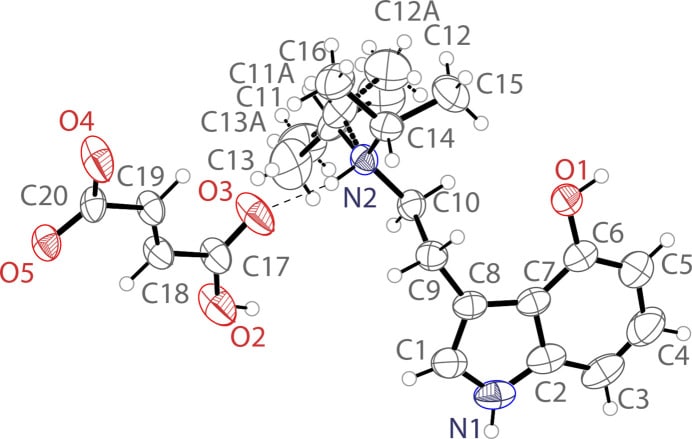
CaaMTech, in collaboration with the Manke Lab at UMass Dartmouth, has published the first crystal structure of 4-hydroxy-N,N-diisopropyltryptamine (4-HO-DiPT). The study, titled “4-Hydroxy-N,N-diisopropyltryptammonium hydrofumarate,” was published in IUCrData. 4-HO-DiPT is currently being evaluated for its therapeutic potential as the active metabolite of 4-glutarato-DiPT, a compound in Phase 2 clinical trials for depression-related indications.
4-HO-DiPT is a 4-substituted tryptamine and a synthetic structural analog of both serotonin and psilocin. It is known for its rapid onset, brief duration, and intense psychoactive effects. Psilocin binds broadly across the serotonin receptor system, interacting with ten of the fourteen known subtypes. In contrast, 4-HO-DiPT engages only three, suggesting a more selective receptor profile that may enable more targeted therapeutic applications. Importantly, 4-HO-DiPT’s short duration of action of 2-3 hours directly addresses one of the field’s central challenges: reducing clinician time required for supervised psychedelic therapy sessions.
Characterizing 4-HO-DiPT’s crystal structure is both timely and foundational. A prodrug of this compound (4-glutarato-N,N-diisopropyltryptamine, or 4-gluatarato-DiPT) is currently being evaluated in Phase 2 clinical trials for postpartum depression and adjustment disorder. CaaMTech previously published the first two crystal structures of 4-glutarato-DiPT, demonstrating its propensity to form solvates, such as ethanol and methanol solvates. Until now, however, the solid-state structure of the pharmacologically active metabolite, 4-HO-DiPT, had never been published.
Prior to CaaMTech’s focus on chemical precision and crystallographic characterization, tryptamines such as 4-HO-DiPT had been described in the literature abstractly or imprecisely. For example, a 2024 ACS Chemical Neuroscience publication documented highly impure 4-glutarato-DiPT containing 9.4% pyridine and 9.6% dichloromethane by weight at the time of characterization and without regard to the possible presence of solvated forms. CaaMTech’s publication provides the field with a defined, stable, and scientifically rigorous reference form of a compound central to current therapeutic innovation. “This publication lays a necessary foundation for the development of 4-HO-DiPT and its prodrugs as pharmaceuticals,” explained Dr. Andrew Chadeayne, CaaMTech CEO. “We are proud to make this essential contribution to the scientific understanding of a drug that has received so much attention for its therapeutic potential.”